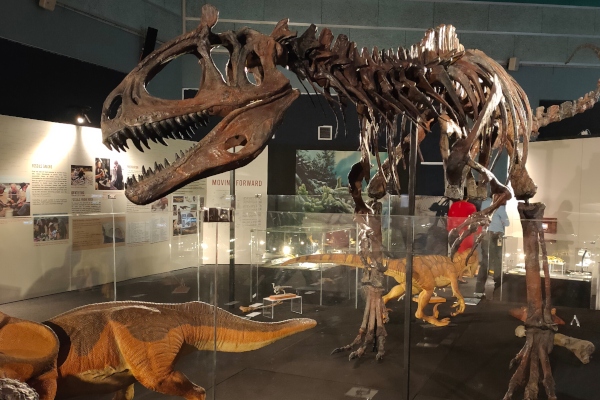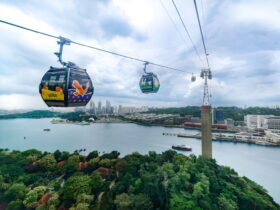Here’s your chance to be a paleontologist for a day!
Photos: Weekender

Put on your explorer vest and boots for DinoQuest, the new exhibition at the Science Centre that invites you to relive your childhood obsession with dinosaurs! If you or your little ones dream of being a paleontologist and go hunting for dinosaurs, this exhibition is one you cannot miss. On top of learning more about the long-extinct creatures through specimens and reconstructions, visitors also step into a scientist’s shoes and go on an interactive expedition.
More specifically, visitors get a taste of what it was like when renowned paleontologist Dr Patricia Vickers-Rich and her team mined the tunnels of Australia’s Dinosaur Cove, and discovered many notable polar dinosaur fossils during the 1980s and 1990s. Before beginning the quest, all visitors will register their individual i-DinoTag. Throughout the seven thematic zones of the exhibition, there are various screens to scan your i-DinoTag and progressively extract your own fossil from rocks, identify and analyse it.

Using advanced technology and immersive storytelling, DinoQuest creates an experience that’s both informative and entertaining. Visitors are led through the seven zones not only by the actual guides at the Science Centre, but also by virtual guides paleontologist Professor V and her assistant Rex!

A variety of multimedia technology – from animatronics to holographs and virtual reality – takes us millions of years back to the Cretaceous period, bringing to life the world when Australian polar dinosaurs roamed. Look out for cool little tidbits planted around, such as how the moon in the animatronics accurately appears larger to us in the past than it does now.
We all know that all non-avian dinosaurs have gone extinct, but why and how it happened is still debated by scientists today. At DinoQuest, we learn about a few theories supported by real solid science that is up-to-date and relevant to our present effects of climate change. Dinosaurs may have belonged to ancient ecosystems, but studying them and the past gives us important information to study our present and future. DinoQuest reminds visitors of this and encourages us to come out of the experience with ideas to do something about our world’s environmental problems.


A highlight of the exhibition is seeing the reconstructions of the dinosaurs that Dr Vickers-Rich and her team discovered at Dinosaur Cove. Visitors first encounter these creatures in the second zone, through life-like 3D models and a projection show. There, we get to know more about the habitat, behaviours and diets of the Koolasuchus, Ankylosaur, Pterosaur, Leaellynasaura and Timimus. The last two are extra special to Dr Vickers-Rich and her fellow paleontologist husband Tom Rich, because they are named respectively after their children Leaellyn and Tim, who accompanied the couple to the dig site!
It’s exciting to learn about polar dinosaurs, a lesser known type of dinosaurs that are very unusual, because they were able to put up with extreme darkness and freezing temperatures near the south pole, for prolonged periods of time. To Dr Vickers-Rich, polar dinosaurs were “the toughest dinosaurs on the planet because they were living under the most severe conditions for dinosaurs.” Find out how they endured the conditions at DinoQuest!

But you don’t have to be the child of paleontologists to enjoy the honour. DinoQuest gives you the incredible opportunity to possibly have a fossil named after you! At the laboratory zone, which recreates a paleontologist’s high-tech laboratory, visitors can pick up actual equipment and tools to drill into rocks – original rocks from the Dinosaur Cove site that have not yet been fully processed. You never know, you might actually discover a real fossil, and if you do, the paleontologists behind the exhibition would name it after you!

Another unique hands-on activity is trying out the large drill at the zone that recreates an actual dig site. Push the device down and it will vibrate and make a noise that’s only – and thankfully – a small percentage of how loud it would actually sound like at a real dig site!


Many of the oldest fossils are technically remnants preserved in rocks, and DinoQuest’s last few zones display a fascinating range of original rocks from dig sites. The prints on the rocks tell stories of ancient species that lived during the Cretaceous period. There are also lots of casts and replicas of prehistoric creatures’ skeletons that will leave you in awe.


One reconstruction visitors should not miss – and cannot, anyway – is that of Timimus, a tyrannosauroid discovered at Dinosaur Cove in 1994 and named after Dr Vickers-Rich’s son Tim. It is the most updated reconstruction of the creature, making its world premiere right here in Science Centre Singapore’s DinoQuest!
The dinosaur expedition ends with a few more hands-on activities, including creating your own virtually animated dinosaur and naming it, and finally printing out your certificate for discovering the species.
We definitely recommend anyone who is curious about science at all, or is eager to develop their curiosity, to visit DinoQuest. The exhibition engages visitors in various kinds of scientific inquiry, not just paleontology but also geology and more. We love how the content data provided are both intelligent and accessible to all ages at the same time. Make it a fun and educational day out with the whole family for the June holidays!
The whole exhibition experience takes about 1.5 hours. Tickets are $18 per adult and $15 per child, or $52 per family of two adults and two children. You can get your tickets either online here (enjoy 20% off when you book before 31 May!) or onsite at the Science Centre ticketing counters.
DinoQuest will run from 1 June to 31 August 2019 at the The Annexe, Science Centre Singapore.
15 Science Centre Road, Singapore 609081
All the photographs in this article are unedited and taken using the OPPO Reno Standard Edition smartphone camera.
ADVERTISEMENTS










Leave a Reply